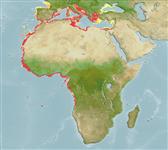Common names from other countries
Environment: milieu / climate zone / depth range / distribution range
Écologie
marin; saumâtre benthopélagique; océanodrome (Ref. 3688); profondeur 1 - 200 m (Ref. 4781), usually 30 - 50 m (Ref. 2683). Subtropical; 45°N - 17°S, 19°W - 36°E
Eastern Atlantic: Portugal and Strait of Gibraltar to Angola, including the Mediterranean.
Length at first maturity / Taille / Poids / Âge
Maturity: Lm 18.7, range 17 - 23 cm
Max length : 90.0 cm SL mâle / non sexé; (Ref. 4781); common length : 50.0 cm SL mâle / non sexé; (Ref. 4781); poids max. publié: 11.6 kg (Ref. 40637)
Generally found in hard bottoms (rocks and rubble), the older individuals in the deeper part of the range, the young in inshore areas. Feed mainly on bivalves and also on crustaceans and fish. Sexual maturity at 2 years old. Spawning migration occurs parallel to the coast with intermittent spawning between spring and autumn over soft bottoms in shallow waters (Ref. 3688).
Life cycle and mating behavior
Maturities | Reproduction | Spawnings | Egg(s) | Fecundities | Larves
A different diagnosis of sexual pattern may arise for this species brought about by geographical variations (Ref. 103751). Also Ref. 41163.
Bauchot, M.-L. and J.-C. Hureau, 1990. Sparidae. p. 790-812. In J.C. Quero, J.C. Hureau, C. Karrer, A. Post and L. Saldanha (eds.) Check-list of the fishes of the eastern tropical Atlantic (CLOFETA). JNICT, Lisbon; SEI, Paris; and UNESCO, Paris. Vol. 2. (Ref. 3688)
Statut dans la liste rouge de l'IUCN (Ref. 130435)
CITES (Ref. 128078)
Not Evaluated
Menace pour l'homme
Harmless
Utilisations par l'homme
Pêcheries: commercial; pêche sportive: oui
Outils
Articles particuliers
Télécharger en XML
Sources Internet
Estimates based on models
Preferred temperature (Ref.
115969): 13.3 - 25.2, mean 17.5 (based on 97 cells).
Phylogenetic diversity index (Ref.
82804): PD
50 = 0.5156 [Uniqueness, from 0.5 = low to 2.0 = high].
Bayesian length-weight: a=0.01995 (0.01695 - 0.02348), b=2.95 (2.91 - 2.99), in cm Total Length, based on LWR estimates for this species (Ref.
93245).
Niveau trophique (Ref.
69278): 3.7 ±0.54 se; based on food items.
Résilience (Ref.
120179): Milieu, temps minimum de doublement de population : 1,4 à 4,4 années (K=0.28; tmax=10; tm=2).
Fishing Vulnerability (Ref.
59153): Moderate to high vulnerability (46 of 100).
Climate Vulnerability (Ref.
125649): Moderate to high vulnerability (54 of 100).
